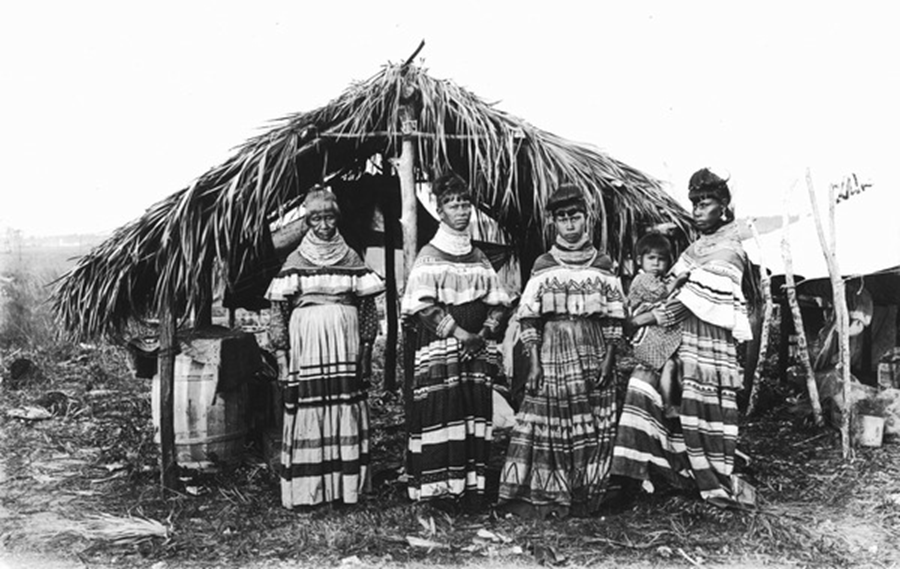Before researching any tribal records, starting with non-Indian sources is a good idea. NARA has several forms of value to persons researching Native American ancestry.
The Dawes Rolls are the final enrollment of individuals found eligible for tribal membership in one of the Five Civilized Tribes in Indian Territory. These records can reveal valuable family information such as the degree of Indian blood and relationship to other tribe members.
Church Records
Churches and their records can be valuable for researching your Native American ancestors. These records can include membership and sacramental (baptisms, confirmations, marriages, and burials) records, diaries or journals of pastors and ministers, and other administrative documents such as board minutes, financial reports, annual congregational meetings, Women’s Alliance records, music programs, religious education curricula and programs, and correspondence between the church office and parishioners.
Church records can be found in original manuscripts, microfilmed, published, and digitized formats. When analyzing these records, consider the period in which your ancestors lived and the specific denomination of the church.
Start by searching the Internet for the local church’s website. Many churches now post their collection information and a detailed finding aid online.
Be polite and patient when inquiring at church offices about their records. They aren’t obligated to fulfill genealogical requests.
If a particular church hasn’t posted its information online, look for a regional or nationwide archive with collections from that denomination. Search the Native American records for your denomination and the paper on the location of documents in your state. You may also want to consult the bibliographies for your denomination’s publications for more information on finding their archives. Once you’ve located potential archives, search the online catalogs of those archives using the same strategies described in the previous article.

Census Records
Usually, the first type of record is located when doing a general search on a genealogy platform; census records are invaluable snapshots of your family at a particular time. They provide a wealth of genealogical information that may not be found in other records, such as birthplace, date of death, and relationships.
While a good source of information, censuses have their limitations. The original purpose of the census was not to record genealogically significant information but rather to assist the government in making decisions regarding apportionment of congressional seats and the distribution of federal resources.
In addition, a lack of consistency in recording names can make them difficult to search. First and middle terms are frequently interchanged; nicknames or initials are used; or ages are reported inconsistently. Genealogists often refer to the original image of a census record for clues that may lead them to other forms such as vital, church, cemetery, court, land/deeds/taxes, military, immigration, and naturalization.
Fortunately, most decennial US censuses are now available online for research. You can access them at Ancestry or FamilySearch, or check with your local library to see if they have subscriptions to these sites that allow patrons to use these records at the library and even from home using their library card.
Military Records
Generally, military records can provide a fuller picture of an ancestor’s life. They can offer clues to the tribe an ancestor belonged to and help determine if that ancestor was involved in particular conflicts. These records can also help locate family members who may have served as a wife, child, or mother of a soldier. Individual service and pension files can offer much information about an ancestor’s life and family, including many personal wartime letters.
For those with ancestors who served in the Civil War, the National Archives has a separate series of medical cards for regular and volunteer soldiers. These are similar to the cards used in CMSRs, but they contain more details, such as the hospital or station where the soldier was admitted and their diagnosis and treatment.
If your ancestor was a member of the Army, Navy, or Marines, you may find them in the digitized collection on Fold3. This free site contains all the service records digitized as of September 2015. For those who fought for the Confederacy during the Civil War, a search feature allows researchers to search by state and name at the time of enlistment.
Dawes Rolls
The Dawes Rolls are critical records for researching Native American ancestors. The rolls listed individuals eligible for tribal membership in the Cherokee, Creek, Choctaw, Chickasaw, or Seminole tribes from 1898-1914 and were entitled to land. The records can include the person’s name, blood degree, sex, and census card number. The card numbers are unique and can help you find other documents about the person, such as family members or other tribal paperwork. For example, a card for Myrtle Bryant includes her husband and two sons (see the image below).
To be enrolled in the Five Civilized Tribes and receive an allotment of land, citizens needed to prove their status by listing relatives on these rolls. These records have proved vital to many families and are critical for anyone seeking their ancestors in Indian Territory.
Although the records are not always complete, they can provide valuable clues to a researcher’s next steps. For example, these records indicate that William Folsom was a member of the Mississippi Choctaw Nation. This helped researchers trace his lineage and confirm that he was a Dawes enrollee who received land. The complete Dawes roll records have been digitized and are available through the National Archives and Family Search.

